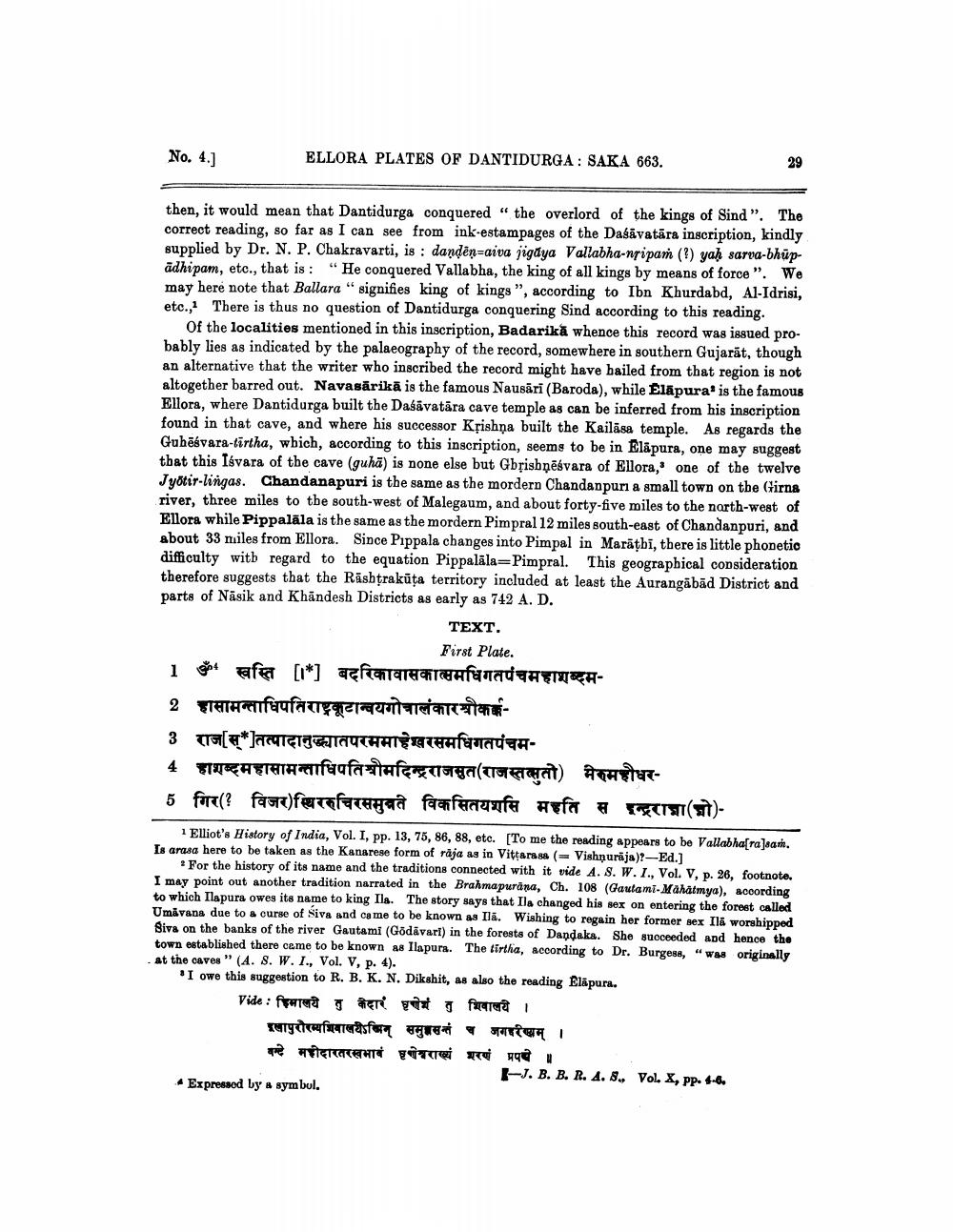________________
No. 4.]
ELLORA PLATES OF DANTIDURGA : SAKA 663.
then, it would mean that Dantidurga conquered “ the overlord of the kings of Sind". The correct reading, so far as I can see from ink-estampages of the Dasavatāra inscription, kindly supplied by Dr. N. P. Chakravarti, is : dandên=aiva jigaya Vallabha-npipar (?) yaḥ sarva-bhūpadhipam, etc., that is: "He conquered Vallabha, the king of all kings by means of force". We may here note that Ballara “ signifies king of kings ”, according to Ibn Khurdabd, Al-Idrisi, etc., There is thus no question of Dantidurga conquering Sind according to this reading.
of the localities mentioned in this inscription, Badarikā whence this record was issued probably lies as indicated by the palaeography of the record, somewhere in southern Gujarāt, though an alternative that the writer who inscribed the record might have bailed from that region is not altogether barred out. Navasärikā is the famous Nausāri (Baroda), while Elāpura' is the famous Ellora, where Dantidurga built the Daśavatāra cave temple as can be inferred from his inscription found in that cave, and where his successor Kțishna built the Kailāsa temple. As regards the Guhēsvara-tirtha, which, according to this inscription, seems to be in Eläpura, one may suggest that this Isvara of the cave (guha) is none else but Gbrisbņēsvara of Ellora, one of the twelve Jyotir-lingas. Chandanapuri is the same as the mordern Chandanpuri a small town on the Girns river, three miles to the south-west of Malegaum, and about forty-five miles to the north-west of Ellora while Pippalāla is the same as the mordern Pimpral 12 miles south-east of Chandanpuri, and about 33 miles from Ellora. Since Puppala changes into Pimpal in Marātbi, there is little phonetic difficulty with regard to the equation Pippaläla=Pimpral. This geographical consideration therefore suggests that the Rashtrakūta territory included at least the Aurangābād District and parts of Nāsik and Khandesh Districts as early as 742 A. D.
TEXT.
First Plate. i o afer [1*] aefatarefa ETA2 हासामन्ताधिपतिराष्ट्रकूटान्वयगोत्रालंकारीकर्क3 राज[*]तत्पादानुझ्यातपरममाहेश्वरसमधिगतपंचम4 हाशब्दमहासामन्ताधिपतिश्रीमदिन्द्रराजसुत(राजस्तत्मतो) मेरुमहौधर5 fore(? facra)ferefter fa#federf hefa # (T)
1 Elliot's History of India, Vol. I, pp. 13, 75, 86, 88, etc. (To me the reading appears to be Vallabha[rajaan. Is arasa here to be taken as the Kanarese form of raja as in Vittarssa ( Vishnurija)? -Ed.]
For the history of its name and the traditions connected with it vide A. S.W. I., Vol. V, p. 26, footnote. I may point out another tradition narrated in the Brahmapurana, Ch. 108 (Gautami. Mahatmya), according to which Ilapura owes its name to king Ils. The story says that Ils changed his sex on entering the forest called Umivana due to a curse of Siva and came to be known as Il. Wishing to regain her former sex Ila worshipped Siva on the banks of the river Gautami (Gödávarl) in the forests of Dandaka. She succeeded and hence the
town established there come to be known as llapura. The tirtha, according to Dr. Burgess,"was originally . at the caves" (A. 8. W. I., Vol. V, p. 4). "I owe this suggestion to R. B. K. N. Dikshit, as also the reading Eläpura.
Vide: हिमालये तु केदारं वृणेयं तु शिवालये ।
इसापुरोरग्यशिवालयऽचिन् समुशासनं च जगराम् । वन्दे महीदारतरखभावं पृणेशराख्यं शरणं प्रपये ।
E . B. B. R. 4. 8., Vol. X, PP. 4-6. - Expressed by a symbul.




